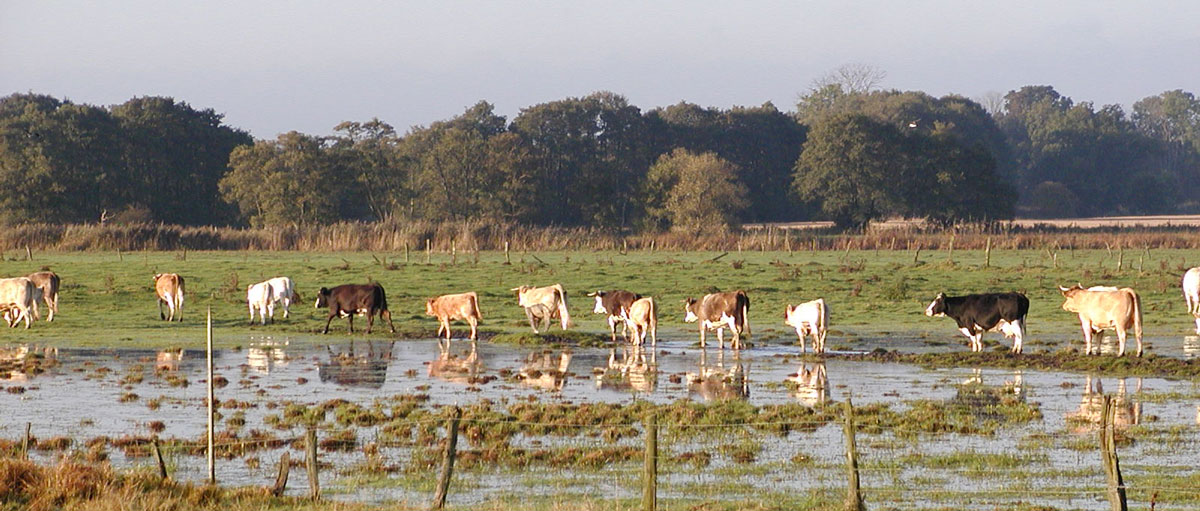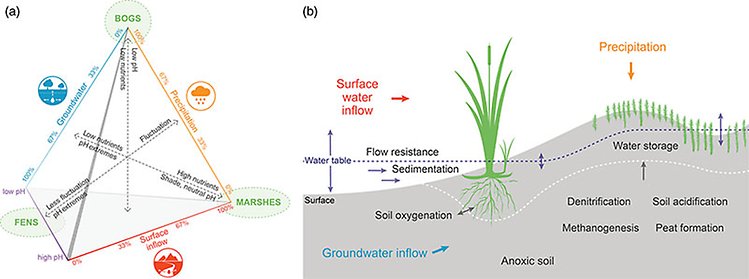
Traits define species in terms of their ecological roles and how they interact with their surroundings. A new study show which traits are typical of wetland plants and how these traits behave in different wetland types. Photo: S.E. Magnusson/Kristianstad Vattenrike
Bildtext får vara max två rader text. Hela texten ska högerjusteras om den bara ska innehålla fotobyline! Photo: B. Christensen/Azote
Ecology of ecosystem services
The work of wetlands
Understanding plant traits key to more complete picture of the ecology of wetland ecosystem services
• There are knowledge gaps in the ecology of wetlands that need to be overcome to improve the management of their many ecosystem services
• Centre researchers analyse plant traits to address this gap and explain why a “trait-based ecology” is key to make better wetland management decisions
• Their data and model is openly available for other scientists to improve, e.g. by modifying the scripts used to generate an interactive figure
Wetlands like bogs, fens and marshes provide numerous ecosystem services for people, fish and wildlife. Some of these services include protecting and improving water quality, storing floodwaters and regulation of climate.
Without a complete picture of the underlying ecology, however, it is difficult to provide meaningful recommendations for the management of these ecosystem services.
Traditionally, ecologists have focused their studies on species richness and genetic composition to understand ecology, but there is still a lack of understanding when it comes to the actual “jobs” that different species perform. One increasingly popular way of looking into this aspect is to focus on so-called functional traits. Traits are the features that define species in terms of their ecological roles, how they interact with the environment and with other species.
Centre researchers Helen Moor and Jon Norberg use such a “trait-based” approach to study wetlands in a new study done together with colleagues from Stockholm University, Uppsala University and the Swedish University of Agricultural Sciences. The study was published in Journal of Ecology.
Traits have the potential to become the fundamental unit of ecology, a common currency that can unify mechanistic knowledge from diverse ecosystems
Helen Moor, lead author
Traits and drivers
The study is part of an emerging view that by measuring and understanding trait diversity, we can make better conservation and restoration decisions.
A trait can be described as any measurable feature of an individual organism that potentially affects function or evolutionary success. For trees in a forest such traits could include seed mass, leaf mass per area, and wood density. For the wetland plants, Moor, Norberg and colleagues use traits like root depth, thickness of leaves, and water use efficiency.
The majority of studies on trait-process linkages, however, has been developed in land-based habitats, especially grasslands. In wetlands, the approach is still comparatively less well studied, the authors write.
The study takes as its starting point the assumption that the environmental conditions (“drivers”) determining wetland type cause a distinct pattern of traits (“a functional signature”) in the local plant community. This in turns affects most of the processes involved in ecosystem services generation. In wetlands, the most important driver is the source of water, which influences the water’s chemical composition and its depth, as well as the frequency and duration of flooding. These hydrological and chemical conditions are also the reasons that the dominant vegetation differs between wetland types.
“In peatlands, habitat-trait interactions are particularly strong: not only must present species have traits to endure the particular environmental conditions, like low pH values and low nutrient availability, but these conditions are also strongly influenced by the traits of dominant species,” the authors explain.

Water flow and chemistry are key determinants of wetland type and prevalent processes. "Towards a trait-based ecology of wetland vegetation" in Journal of Ecology, DOI: 10.1111/1365-2745.12734
Online interactive summary
The aim of the study, the authors explain, is to establish a framework that can help improving the understanding of how environmental conditions are linked to ecosystem functioning and the ecosystem services potential of wetlands. A future goal would be to move towards quantification, but at this stage this is only possible for a few links.
After reviewing the environmental conditions that determine whether the wetland becomes a bog, fen or a marsh, the authors analyse which traits are typical of wetland plants and how these traits behave in different wetland types. This knowledge is then analysed in terms of its influence on the three ecosystem services: climate regulation, water flow and water quality regulation. Special emphasis is put on highlighting knowledge gaps and research needs, including a call for future collaboration through making their data and model openly available for other scientists to improve.
“The main output is an online interactive summary of the literature in which causes and effects are traced from large-scale environmental drivers that define local conditions, which in turn select for trait values with final effects on ecosystem processes and services”, they write.
Watch the online interactive summary below or study it more in detail here
Methodology
A qualitative framework is established to guide and facilitate work on scaling from environmental conditions to ecosystem functioning and ecosystem services potential for wetlands. A future goal is to move towards quantification, but at this stage this is only possible for a few links. The authors review environmental drivers that determine the wetland type (bog, fen, marsh); ask which traits are typical of wetland plants; and how commonly measured traits behave in wetland environments. They then identify the properties and processes that underlie the three service complexes of climate regulation, water flow and water quality regulation, and review the knowledge base for trait effects on these, highlighting knowledge gaps and research needs. Outputs include an online interactive summary of the literature and a figure that is openly available for other scientists to improve, see: https://zahachtah.github.io/WetlandTraitDriver
Moor, H., Rydin, H., Hylander, K., Nilsson, M.B., Lindborg, R., Norberg, J. 2016. Towards a trait-based ecology of wetland vegetation. Journal of Ecology, 10.1111/1365-2745.12734
Helen Moor is a PhD student at the centre. Her research focuses on the response of wetland plants to climate change, and potential implications for ecosystem functioning and the delivery of ecosystem services
Jon Norberg works with conceptual development of the resilience and complex adaptive systems (CAS) frameworks.






